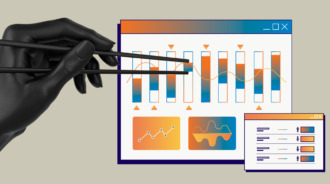

Every trader has doubts when choosing an entry point. This article shows the six steps used in the Stairs trading strategy while applying the Stochastic indicator. You will also cover some significant benefits and limitations.
What is the Stairs trading strategy?
The Stairs trading strategy is a technical analysis strategy that facilitates the identification of support and resistance levels in a market. It carries out the analysis to look for price movements. The entry point is what a trader wants, and the Stairs strategy helps to find that by studying the market price movement pattern. After all, the goal is to decide on entering a trade in time and getting a profit.
Price always swings in a financial market. It does not matter if we trade in short-term or long-term. The prices always pull towards the direction of the prevailing trends with temporary pullbacks or consolidations throughout. This phenomenon depicts the formation of a stairs-like structure.
The Stairs strategy has been formulated on the price movement toward stairs. Each step of this pattern depicts one level of support and resistance. Thus, with the correct identification of these levels, the Stairs strategy enables you to profit by knowing the right entry point in a trade.
However, you can use this strategy only if you understand and apply it to the Stochastic indicator. Let’s see what that is.
Importance of using the Stochastic indicator
The stochastic indicator is 50 years old; George Lane developed it. At this point, you might think it is an old indicator, but that is only until you go through this article in detail. It still retains its importance among traders because it provides stable trade entry signals.
The Stochastic indicator measures the current trend and is therefore regarded as a momentum indicator. It highlights whether the current trend is weak or strong and, within a trend, whether it is a condition of overbought or oversold.
How to use the Stochastic indicator?
You should check the procedure below if you want to make trading decisions through the Stochastic indicator.
This indicator is straightforward to use. If the moving average is high, generally 80 lines or above, then it is a condition of overbought. If the moving average is low, say below 20 lines, it depicts a state of oversold.
The following image will make it easier for you to comprehend this.
The default settings for the stochastic indicator are 14, 3, and 1. You must change the default settings if you want to open a short-term trade and know the slightest price movements. In this case, you can bring down the default setting of the Stochastic indicator to 5 bar for the slow-moving average. At the same time, the fast-moving average should be left untouched at 3.
This setting will make the indicator more sensitive toward the short-term market swings in price. It thus becomes an effective indicator for short-term trading.
Now is the time to check the center mass of this article — six steps to trading profits.
Six steps on how to trade the Stairs strategy
The following six steps will be your means of deciding whether to enter a trade:
- The first step is to identify a strong bullish market.
- Use the Stochastic indicator and wait for it to form a double bottom pattern. The second bottom should be higher than the first one.
- To remain overbought, both the Stochastic swing lows must remain below level 20.
- Wait for a divergence to develop between the market price and the stochastic indicator.
- Enter a trade after the second bottom develops a stochastic crossover.
- Place the stop loss below the last swing low to keep the risks minimum. As and when the slow stochastic moving average enters an overbought condition above 80 levels, get your profit.
So, using this technique, you can see the signals and enter the trade in time.

Advantages of the Stairs strategy
Effective decision-making is only one advantage; let’s see some more benefits:
- It offers the ability to spot significant levels of support and resistance.
- It makes it easier to identify patterns during price movements.
- The step-by-step technique that it offers enables a consolidated and careful approach.
- It offers a practical ability to adapt to different markets.
Thus, by applying this strategy while trading, you can see the correct signal to enter the trade.
Risks involved with the Stairs strategy
A few associated risks to be aware of when trading the Stairs strategy:
- The market depends on factors such as economic activity, news, etc. Thus, ignoring them in plans can lead to wrong trading decisions.
- Be careful about overbuying. One wrong decision and timeline can lead to losses. Cautious decisions are what should be looked at by all traders.
- The possibility of taking rapid and irrational moves based only on the screen image may lead to losses. Your trading decisions must be based on a combined confirmation from various indicators and signals.
- Remember that emotions in trade are not at all helpful and, in most cases, lead to losses.
Consider these risks when trading with the Stairs strategy to avoid losing the funds invested in the trade.
The bottom line
The trade entry and exit timing is considered the most crucial decision for all trading-related activities. The Stairs strategy, when applied to the Stochastic indicator, bears fruitful decisions. This step-by-step technique assists traders in all markets. The advantage of using the Stairs strategy following the above given enables effective decision-making. But remember, trading is always risky and diligent use of techniques can help reduce the possibilities of losses.







